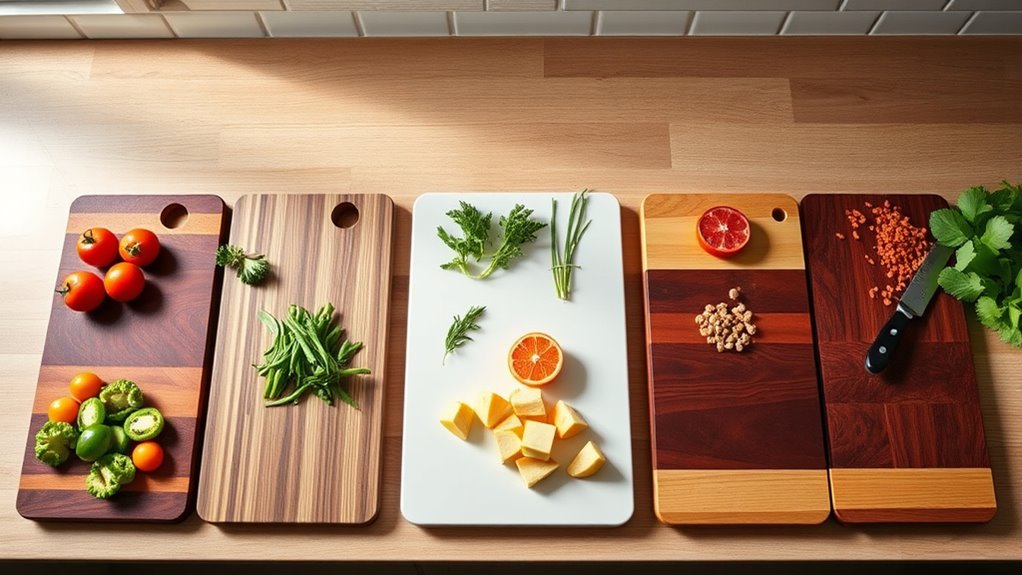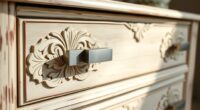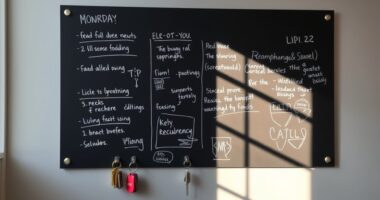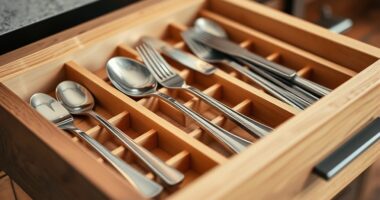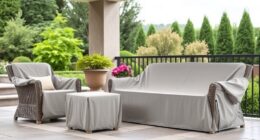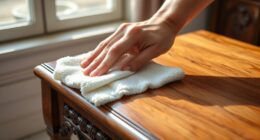To master five foolproof cutting board layouts, start by dividing your workspace into zones for vegetables, meats, and herbs, keeping each section separate. Use a scrap container for peels and scraps to stay tidy, and organize ingredients in order of use for a smooth flow. Store your knife safely when not in use, and arrange everything to minimize movement and cross-contamination. Keep these simple setups in mind to boost your confidence—your next prep session will be safer and more efficient.
Key Takeaways
- Divide the cutting board into dedicated zones for vegetables, meats, and herbs to prevent cross-contamination.
- Place a scrap bowl at one corner to keep the workspace tidy and minimize reaching across ingredients.
- Follow a logical prep order, starting with the cleanest items and handling raw meat last for safety.
- Designate a specific spot for the knife, such as a magnetic strip, to ensure quick access and safe storage.
- Arrange ingredients in the order they are used to streamline workflow and reduce unnecessary movement.
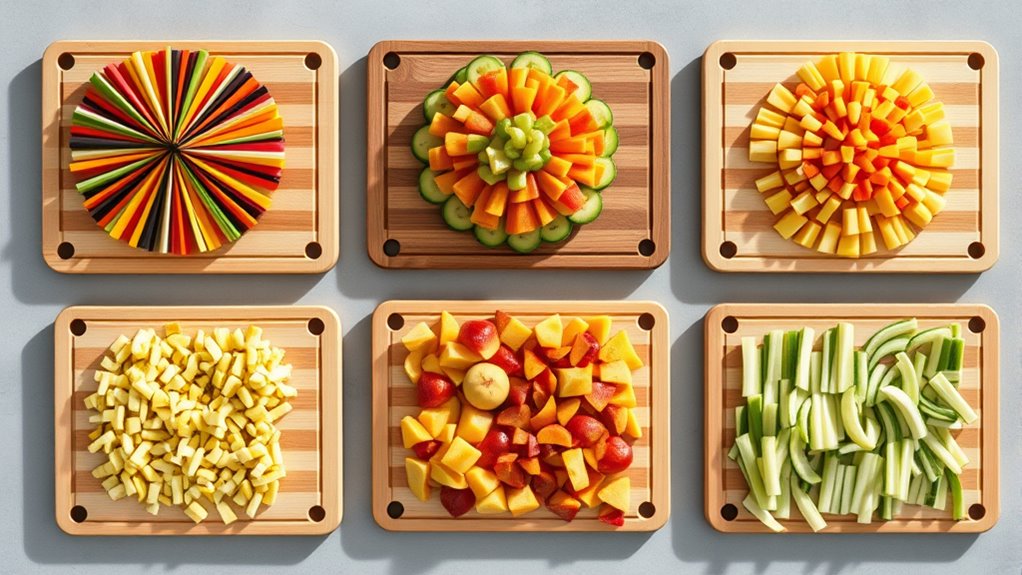
A well-organized cutting board setup can make your kitchen tasks safer and more efficient, but figuring out the best layout isn’t always straightforward. When you’re preparing ingredients, a thoughtful arrangement helps you avoid cross-contamination, streamline your workflow, and keep knife safety top of mind. The goal is to minimize moving around the board and reaching for utensils or ingredients unnecessarily. By establishing a clear layout, you’ll find ingredient prep quicker and safer, reducing the risk of accidents.
One simple but effective layout is to allocate different zones for each ingredient. Imagine dividing your cutting board into sections: one for vegetables, one for meats, and a small area for herbs or spices. As you work, you can focus on one zone at a time, which keeps raw meat separate from produce and helps prevent cross-contamination. This setup also enhances knife safety—by focusing on one type of ingredient, you’re less likely to slip or cut into the wrong item. Plus, it keeps your workspace tidy, so you don’t have to shuffle ingredients around and risk knocking over a knife or contaminating other items.
Divide your cutting board into zones for vegetables, meats, and herbs to prevent cross-contamination and improve safety.
Another layout involves placing a bowl or container at one corner of the board to collect scraps and discarded peels. This keeps your workspace clean and reduces clutter, making ingredient prep more efficient. When your scraps are right beside you, you don’t have to reach across the board or search for trash, which can be dangerous when you’re focused on cutting. Keeping your cutting tools and ingredients close together minimizes movement, helping you stay focused and reducing the chance of accidents. It also means you can easily transfer chopped ingredients into pots or bowls without juggling multiple items.
A third layout centers around the order of prep—think of it as an assembly line. Start with your cleanest ingredients first, then move to those that need more prep. For example, cut herbs or vegetables first, then handle raw meat last. This logical flow keeps your knife safety in check because you’re less likely to cross-contaminate. As you work, keep your knives sharp and focused on one task at a time, which reduces slips and cuts. Organize your ingredients in the order they’ll go into the recipe, so your workflow remains smooth and safe.
Finally, consider a layout that emphasizes a designated space for your knife. Keep your knife on a separate side of the board or in a magnetic strip nearby. This way, when you’re done chopping, you’re not dragging the blade across the surface, which can dull the edge or cause accidents. Having a specific spot for your knife improves safety and makes it quick to grab or store it between tasks, keeping your ingredients prep efficient and safe.
Frequently Asked Questions
What Materials Are Best for Durable Cutting Boards?
When choosing materials for durable cutting boards, you should consider wood durability and plastic safety. Hardwoods like maple and walnut are excellent because they resist knife marks and are gentle on your knives, making them highly durable. Plastic boards are safe too, especially high-density polyethylene, which is lightweight, dishwasher safe, and resistant to bacteria. Both options provide long-lasting performance, but always prioritize quality to guarantee safety and durability in your kitchen.
How Do I Sanitize My Cutting Boards Effectively?
To sanitize your cutting boards effectively, you need to follow proper cleaning solutions and sanitizing techniques. First, wash your board with hot, soapy water to remove debris. Then, use a solution of diluted bleach or vinegar for sanitizing, ensuring you cover all surfaces. Let it sit for a few minutes, rinse thoroughly, and dry completely. Regularly repeating these steps keeps your boards safe and germ-free.
Can I Use the Same Layout for Different Food Types?
You can use the same layout for different food types, but it’s not recommended because cross contamination risks increase. To maintain good kitchen hygiene practices, use separate areas or boards for raw meats, vegetables, and cooked foods. This helps prevent bacteria transfer. Always sanitize your cutting boards thoroughly after each use, especially when switching between food types, to keep your kitchen safe and clean.
How Often Should I Replace My Cutting Boards?
Imagine slicing a ripe tomato and then chopping raw chicken on the same board—it’s easy to forget about food safety. You should replace your cutting boards every few years, or sooner if they develop deep cuts or stains. Regularly updating your boards helps maintain kitchen organization and prevents cross-contamination, keeping your food safe. Trust your senses and replace them when they show signs of wear for peak safety and cleanliness.
Are There Specific Colors to Prevent Cross-Contamination?
You might wonder if specific colors help prevent cross-contamination. Using color coding for your cutting boards is a smart move. Assign different colors to different foods—like red for meat, green for vegetables, and blue for seafood—to keep contamination prevention simple and effective. This way, you reduce the risk of bacteria spreading between food types, making your kitchen safer and more organized with minimal effort.
Conclusion
With these five foolproof layouts, you’re all set to become confident in the kitchen. You don’t need fancy tools or years of experience—just a simple plan and some practice. As you master each layout, your prep becomes smoother, your space more organized. It’s a balance between beginner and pro, chaos and control. So, grab your board, choose your layout, and enjoy the process. Because in cooking, confidence turns effort into enjoyment.
